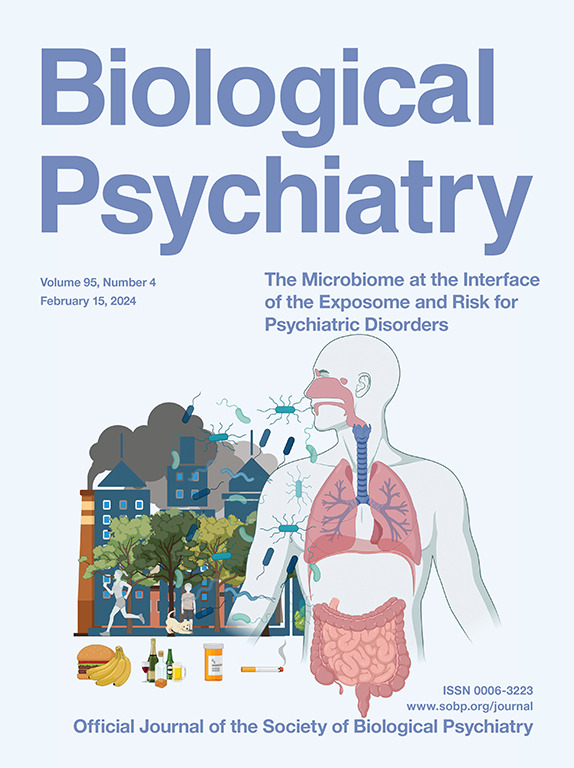A Population-Based Multigenerational Family Coaggregation Study of Severe Infections and Obsessive-Compulsive Disorder
IF 9.6
1区 医学
Q1 NEUROSCIENCES
引用次数: 0
Abstract
Background
Postinfectious autoimmune processes have been proposed as potential causal risk factors for obsessive-compulsive disorder (OCD). In this large population-based study, we aimed to clarify the familial coaggregation pattern between severe infections and OCD across clusters of relatives with varying degrees of relatedness.
Methods
We identified 4,916,898 individuals born in Sweden between 1960 and 2008 and followed them until the end of 2020. Each individual was linked to their first-, second-, and third-degree relatives, including monozygotic and dizygotic twins, mothers, fathers, full siblings, maternal and paternal half siblings, aunts, uncles, and cousins. OCD and infection diagnoses from inpatient and specialized outpatient settings were retrieved from the Swedish National Patient Register. We compared the risk of OCD in relatives of probands with severe infections to those of probands without severe infections. Cox proportional hazard regression models, incorporating time-varying exposures, were used to estimate hazard ratios. Dose-response associations were examined using logistic regression models.
Results
Relatives of probands with severe infections had a higher risk of OCD, which increased with genetic relatedness, with hazard ratios (95% CI) ranging from 1.46 (1.07–1.98) in monozygotic twins to 1.10 (1.09–1.11) in cousins. The results remained robust after adjusting for severe infections among relatives, OCD in probands, and comorbid autoimmune disorders in both probands and relatives. A dose-response association was observed between the number of infections in the probands and their odds of OCD, as well as in their relatives.
Conclusions
The results strongly suggest that the association between severe infections and OCD may be largely driven by shared genetic factors.
以人口为基础的严重感染与强迫症多代家庭共聚研究。
背景:感染后自身免疫过程被认为是强迫症(OCD)的潜在致病因素。这项基于人群的大型研究旨在阐明不同亲缘关系的亲属群中严重感染与强迫症之间的共同聚集模式:我们确定了 1960 年至 2008 年间在瑞典出生的 4,916,898 名个体,并对他们进行了跟踪调查,直至 2020 年。每个人都与他们的一级和二级亲属建立了联系,包括单卵(MZ)和双卵(DZ)双胞胎、母亲、父亲、兄弟姐妹、同父异母和同母异父的兄弟姐妹、姑姑、舅舅和表兄弟姐妹。我们从瑞典全国病人登记册中检索了住院病人和专科门诊病人的强迫症和感染诊断。我们比较了患有严重感染的原发性患者亲属与未患有严重感染的原发性患者亲属患强迫症的风险。我们使用包含时变暴露的 Cox 比例危险回归模型来估算危险比 (HR)。使用逻辑回归模型检验了剂量-反应关系:严重感染者的亲属患强迫症的风险较高,随着遗传亲缘关系的增加而增加,HRs(95% CI)从MZ双胞胎的1.46(1.07-1.98)到表兄弟姐妹的1.10(1.09-1.11)不等。在调整了亲属间的严重感染、受试者的强迫症以及受试者和亲属的合并自身免疫性疾病后,结果仍然保持稳定。探究者的感染次数与他们及其亲属患强迫症的几率之间存在剂量反应关系:结论:研究结果有力地表明,严重感染与强迫症之间的关联可能在很大程度上是由共同的遗传因素驱动的。
本文章由计算机程序翻译,如有差异,请以英文原文为准。
求助全文
约1分钟内获得全文
求助全文
来源期刊

Biological Psychiatry
医学-精神病学
CiteScore
18.80
自引率
2.80%
发文量
1398
审稿时长
33 days
期刊介绍:
Biological Psychiatry is an official journal of the Society of Biological Psychiatry and was established in 1969. It is the first journal in the Biological Psychiatry family, which also includes Biological Psychiatry: Cognitive Neuroscience and Neuroimaging and Biological Psychiatry: Global Open Science. The Society's main goal is to promote excellence in scientific research and education in the fields related to the nature, causes, mechanisms, and treatments of disorders pertaining to thought, emotion, and behavior. To fulfill this mission, Biological Psychiatry publishes peer-reviewed, rapid-publication articles that present new findings from original basic, translational, and clinical mechanistic research, ultimately advancing our understanding of psychiatric disorders and their treatment. The journal also encourages the submission of reviews and commentaries on current research and topics of interest.
 求助内容:
求助内容: 应助结果提醒方式:
应助结果提醒方式:


